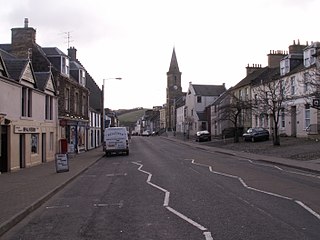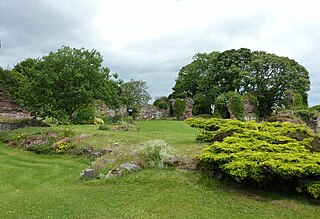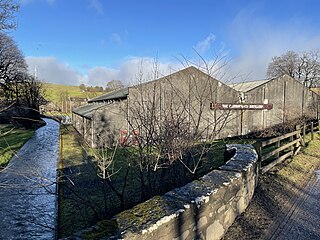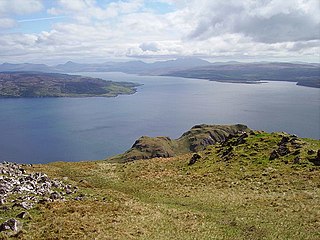
Dufftown is a burgh in Moray, Scotland. While the town is part of the historic Mortlach parish, the town was established and laid out in the early 19th century as part of a planned new town settlement. The town has several listed 19th century buildings and serves as a regional centre for agriculture, tourism and services. The town is well known for its whisky based economy, as it produces more whisky than any other town in Scotland and is home to several existing and former distilleries.

Glengoyne distillery is a whisky distillery continuously in operation since its founding in 1833 at Dumgoyne, north of Glasgow, Scotland. Glengoyne is unique in producing Highland single malt whisky matured in the Lowlands. Located upon the Highland Line, the division between the Highlands and Lowlands of Scotland, Glengoyne’s stills are in the Highlands while maturing casks of whisky rest across the road in the Lowlands.

Newburgh is a royal burgh and parish in Fife, Scotland, at the south shore of the Firth of Tay. The town has a population of 2,171, which constitutes a 10% increase since 1901 when the population was counted at 1,904 persons.
Kilchoman distillery is a distillery that produces single malt Scotch whisky on Islay, an island of the Inner Hebrides. Kilchoman Distillery is in the northwest of the island, close to Machir Bay. Kilchoman was founded by Anthony Wills and remains an independent, family run distillery. It is the smallest on the island but since obtaining Rockside Farm in 2015, is in the process of expanding.

Lindores Abbey was a Tironensian abbey on the outskirts of Newburgh in Fife, Scotland. Now a reduced ruin, it lies on the southern banks of the River Tay, about 1-mile (1.6 km) north of the village of Lindores and is a scheduled ancient monument.
Lochside distillery was a distillery in Montrose, Angus that produced single malt scotch whisky and grain whisky. The distillery was owned by Macnab Distilleries Ltd. and latterly, by Allied Distillers, a subsidiary of the former British drinks and restaurant group Allied Domecq.

Haig is a brand of Scotch whisky, produced by Diageo in Scotland. It was originally manufactured by John Haig & Co Ltd. since the early 1720's.
Cameron Bridge is a village in the conurbation of Levenmouth in Fife, Scotland. It is near to the village of Windygates and 2 miles west of the town of Leven. A distillery was established in the 19th century by the Haig family, which is now part of Diageo. The distillery produces Scotch whisky.

Deanston distillery is a Single Malt Scotch whisky distillery located on the banks of the River Teith, eight miles from the historic town of Stirling, at the gateway to the dramatic Loch Lomond & Trossachs National Park. It is the largest distillery owned by Scotch whisky producer Distell Group Limited, who also own Bunnahabhain Distillery on the Isle of Islay and Tobermory distillery on the Isle of Mull.
Glenturret distillery is two miles northwest of Crieff in Perthshire, Scotland. on the banks of the Turret River. The distillery is hidden in the glen and its secluded location may have contributed to its early history as the site of several illicit bothy stills. The high hills to either side of the distillery were thought to act as lookout points for the smugglers. When Alfred Barnard visited the distillery he described the glen as "a perfect paradise to artists, who come in great numbers to transfer some of its transcendent beauties to canvas". The distillery is located in the parish of Monzievaird and Strowan.
Isle of Barra distillery at Borve, Barra, Scotland is a planned future whisky distillery on Barra. The Barra Distillery company was founded in 2003 but the distillery buildings are still to be constructed. However, wind turbines to power the distillery were installed in 2012 The distillery has become a Community Benefit Society, a vehicle to direct profits to support social and economic development in the community of Barra & Vatersay via a charitable trust. Shares are available to purchase, and it is expected that construction will commence before 2022.
St. Magdalene distillery was a producer of single malt Scotch whisky that operated between 1798 and 1983.

Glendronach distillery is a Scottish whisky distillery located near Forgue, by Huntly, Aberdeenshire, in the Highland whisky district. It was owned by the BenRiach Distillery Company Ltd. The name Glendronach derives from the Scottish Gaelic Gleann Dronach which means "valley of the brambles" or "valley of the blackberries".

The Sound of Mull is a sound between the Inner Hebridean island of Mull and mainland Scotland. It forms part of the Atlantic Ocean.
Dallas Dhu distillery was a producer of single malt Scotch whisky that operated between 1899 and 1983 in Forres, Moray, Scotland. Dallas Dhu means "Black Water Valley" in Gaelic. Its whisky also appeared as a "Dallas Mhor" single malt. In 1899, Alexander Edward designed the Dallas Dhu distillery at the height of the whisky boom. Later he sold the plans and the distillery was built by the blender Wright and Greg. It was acquired by Benmore Distilleries Ltd, which joined DCL in 1929. The stillhouse was destroyed by a fire in 1939, but rebuilt. Production continued until the distillery closed in 1983; it is now a museum.

Wolfburn distillery is a Scotch whisky distillery in Thurso, Caithness, Scotland. After ceasing production in the 1860s, a new distillery of the same name opened in 2013.
Events from the year 1787 in Scotland.
Nc'nean distillery is a Scotch whisky distillery in Drimnin on the Morvern peninsula of the Highlands, Scotland. The distillery is beside the Sound of Mull, opposite the Isle of Mull. The distillery name Nc'nean, comes from "Neachneohain", a Gaelic legend which translates as the Queen of Spirits.
Auchenblae distillery was a scotch whisky distillery in Auchenblae, Kincardine, Aberdeenshire, Scotland.
Dalmunach distillery is a Scotch whisky distillery located in Carron in the whisky region of Speyside. The distillery is owned by Chivas Regal, a subsidiary of Pernod Ricard. The water source comes from the nearby Ballinom Burn, which originates in the Mannoch Hills. The distillery is named for a nearby pool on the River Spey. The distillery is located beside the Speyside Way and Moray Way, long distance footpaths in the region.









